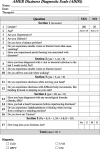Sensitivity and specificity of the amer dizziness diagnostic scale (adds) for patients with vestibular disorders
- PMID: 25642046
- PMCID: PMC4305607
- DOI: 10.1589/jpts.27.91
Sensitivity and specificity of the amer dizziness diagnostic scale (adds) for patients with vestibular disorders
Abstract
[Purpose] To investigate the sensitivity and specificity of a newly developed diagnostic tool, the Amer Dizziness Diagnostic Scale (ADDS), to evaluate and differentially diagnose vestibular disorder and to identify the strengths and weaknesses of the scale and its usefulness in clinical practice. [Subjects and Methods] Two hundred subjects of both genders (72 males, 128 females) aged between 18 to 60 (49.5±7.8) who had a history of vertigo and/or dizziness symptoms for this previous two weeks or less were recruited for the study. All subjects were referred by otolaryngologists, neurologists or family physicians in and around Jeddah, Kingdom of Saudi Arabia. On the first clinic visit, all the patients were evaluated once using the ADDS, following which they underwent routine testing of clinical signs and symptoms, audiometry, and a neurological examination, coupled with tests of Vestibulo-Ocular Reflex function, which often serves as the "gold standard" for determining the probability of a vestibular deficit. [Results] The results show that the ADDS strongly correlated with "true-positive" and "true-negative" responses for determining the probability of a vestibular disorder (r =0.95). A stepwise linear regression was conducted and the results indicate that the ADDS was a significant predictor of "true-positive" and "true-negative" responses in vestibular disorders (R(2) =0.90). Approximately 90% of the variability in the vestibular gold standard test was explained by its relationship to the ADDS. Moreover, the ADDS was found to have a sensitivity of 96% and a specificity of 96%. [Conclusion] This study showed that the Amer Dizziness Diagnostic Scale has high sensitivity and specificity and that it can be used as a method of differential diagnosis for patients with vestibular disorders.
Keywords: Balance; Dizziness; Vestibular.
Figures
Similar articles
-
The clinical and demographic features of dizziness related to general health among the Saudi population.J Phys Ther Sci. 2015 Oct;27(10):3195-8. doi: 10.1589/jpts.27.3195. Epub 2015 Oct 30. J Phys Ther Sci. 2015. PMID: 26644673 Free PMC article.
-
Symptoms and signs of neuro-otologic disorders.Continuum (Minneap Minn). 2012 Oct;18(5 Neuro-otology):1016-40. doi: 10.1212/01.CON.0000421618.33654.8a. Continuum (Minneap Minn). 2012. PMID: 23042058 Review.
-
The clinical utility of search coil horizontal vestibulo-ocular reflex testing.Acta Otolaryngol. 2008 Jan;128(1):29-37. doi: 10.1080/00016480701299642. Acta Otolaryngol. 2008. PMID: 17851913
-
The bucket test differentiates patients with MRI confirmed brainstem/cerebellar lesions from patients having migraine and dizziness alone.BMC Neurol. 2019 Sep 3;19(1):219. doi: 10.1186/s12883-019-1442-z. BMC Neurol. 2019. PMID: 31481007 Free PMC article.
-
Vertigo and dizziness in childhood - update on diagnosis and treatment.Neuropediatrics. 2011 Aug;42(4):129-34. doi: 10.1055/s-0031-1283158. Epub 2011 Jul 15. Neuropediatrics. 2011. PMID: 21766267 Review.
Cited by
-
Aerobic and anaerobic exercise training in obese adults.J Phys Ther Sci. 2015 Jun;27(6):1697-700. doi: 10.1589/jpts.27.1697. Epub 2015 Jun 30. J Phys Ther Sci. 2015. PMID: 26180300 Free PMC article.
-
Weaning from mechanical ventilation: a cross-sectional study of reference values and the discriminative validity of aging.J Phys Ther Sci. 2015 Jun;27(6):1945-50. doi: 10.1589/jpts.27.1945. Epub 2015 Jun 30. J Phys Ther Sci. 2015. PMID: 26180354 Free PMC article.
-
Evaluation of instability in patients with chronic vestibular syndrome using dynamic stability indicators.Med Biol Eng Comput. 2025 Jan;63(1):159-168. doi: 10.1007/s11517-024-03185-x. Epub 2024 Aug 30. Med Biol Eng Comput. 2025. PMID: 39212896
-
Differential diagnosis of dizziness after a sports-related concussion based on descriptors and triggers: an observational study.Inj Epidemiol. 2015 Dec;2(1):22. doi: 10.1186/s40621-015-0055-2. Epub 2015 Sep 17. Inj Epidemiol. 2015. PMID: 27747755 Free PMC article.
-
The clinical and demographic features of dizziness related to general health among the Saudi population.J Phys Ther Sci. 2015 Oct;27(10):3195-8. doi: 10.1589/jpts.27.3195. Epub 2015 Oct 30. J Phys Ther Sci. 2015. PMID: 26644673 Free PMC article.
References
-
- Sloane PD, Coeytaux RR, Beck RS, et al. : Dizziness: state of the science. Ann Intern Med, 2001, 134: 823–832. - PubMed
-
- Al Saif A, Alem HB, Alsenany A: Efficiency of the deep head hanging maneuver for anterior canal benign paroxysmal positional vertigo. J Phys Ther Sci, 2012, 24: 1191–1193.
-
- Al Saif A, Alsenany S: Physical therapy management of anterior canal benign paroxysmal positional vertigo by the Deep Head Hanging Maneuver. J Health Sci, 2012, 2: 29–32.
-
- Saif A, Alsenany S: Dizziness among older adult. J Am Sci, 2012, 8: 305–309.
LinkOut - more resources
Full Text Sources
Other Literature Sources

